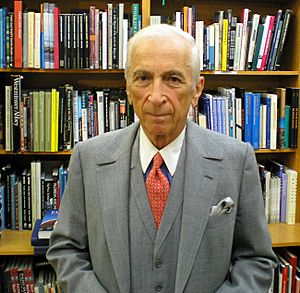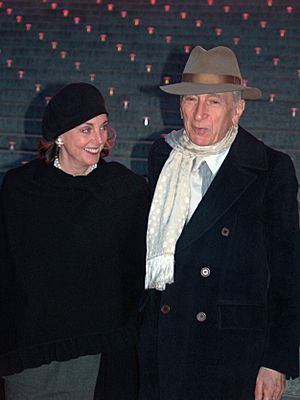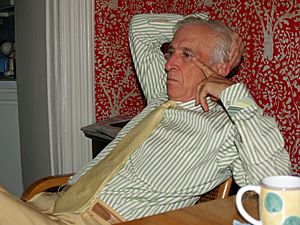Gay Talese facts for kids
Quick facts for kids
Gay Talese
|
|
|---|---|

Talese in 2006
|
|
| Born | Gaetano Talese February 7, 1932 Ocean City, New Jersey, U.S. |
| Occupation | Journalist |
| Alma mater | University of Alabama |
| Genre | Literary journalism, New Journalism |
| Years active | 1961–present |
| Notable works |
|
| Spouse | |
| Children | 2 |
Gaetano "Gay" Talese (/təˈliːz/; born February 7, 1932) is an American writer. He is known for his unique style of journalism. During the 1960s, he wrote for The New York Times and Esquire magazine.
Talese helped create a style called New Journalism. This style uses storytelling techniques usually found in fiction. He is considered a pioneer of this style, along with writers like Joan Didion and Tom Wolfe. Some of his most famous articles are about Joe DiMaggio and Frank Sinatra.
Contents
Early Life and Education

Gay Talese was born in Ocean City, New Jersey. His parents were immigrants from Italy. He finished Ocean City High School in 1949.
How Talese Started Writing
Talese began writing by accident. When he was in high school, he wanted to play more baseball. The assistant coach was supposed to call the local newspaper with game results. But he was too busy. So, the head coach gave this job to Talese.
Talese remembered this in his 1996 essay, "Origins of a Nonfiction Writer":
On the mistaken assumption that relieving the athletic department of its press duties would gain me the gratitude of the coach and get me more playing time, I took the job and even embellished it by using my typing skills to compose my own account of the games rather than merely relaying the information to the newspapers by telephone.
After writing only seven sports articles, Talese got his own column. This was for the weekly Ocean City Sentinel-Ledger. By the time he went to college in September 1949, he had written 311 stories and columns.
Learning to Interview
Talese says his mother taught him how to interview people. He learned to listen carefully and patiently. He never interrupted, even when people struggled to explain things. He believed that pauses and hesitations could reveal a lot about a person.
He wrote in "Origins of a Nonfiction Writer":
I learned [from my mother] ... to listen with patience and care, and never to interrupt even when people were having great difficulty in explaining themselves, for during such halting and imprecise moments ... people are very revealing—what they hesitate to talk about can tell much about them. Their pauses, their evasions, their sudden shifts in subject matter are likely indicators of what embarrasses them, or irritates them, or what they regard as too private or imprudent to be disclosed to another person at that particular time. However, I have also overheard many people discussing candidly with my mother what they had earlier avoided—a reaction that I think had less to do with her inquiring nature or sensitively posed questions than with their gradual acceptance of her as a trustworthy individual in whom they could confide.
College Years
Talese graduated from the University of Alabama in 1953. He chose journalism as his major because he already knew about it. But he said he really became a student of history. While at the university, he joined the Phi Sigma Kappa fraternity.
In college, Talese started using writing techniques from fiction. He would set the "scene" with small details. He also began articles in medias res, which means starting in the middle of the action. During his junior year, he became the sports editor for the campus newspaper, The Crimson White. He started a column called "Sports Gay-zing."
Career Highlights
Starting at The New York Times
After graduating in June 1953, Talese moved to New York City. He found work as a copyboy at The New York Times. Eventually, he got an article published in the Times. It was about the man who managed the headlines in Times Square.
He also wrote an article in 1954 about the chairs on the boardwalk in Atlantic City. But his journalism career was paused when he was drafted into the United States Army in 1954.
Talese had joined the Reserve Officers' Training Corps (ROTC) in college. He was sent to Fort Knox, Kentucky. He trained in the Tank Corps. But he was not good with machines. So, he was moved to the Office of Public Information. There, he worked for an army newspaper called Inside the Turret. He soon had his own column, "Fort Knox Confidential."
Return to Journalism
When Talese finished his military service in 1956, he was rehired by The New York Times. He became a sports reporter. Talese once said, "Sports is about people who lose and lose and lose. They lose games; then they lose their jobs. It can be very intriguing." He was especially interested in boxing. He wrote 38 articles about Floyd Patterson alone.
Later, Talese was sent to cover state politics in Albany. But his careful and detailed writing style bothered his new editors. They called him back to the city. He was assigned to write short obituaries. Talese said, "I was banished to the obituary desk as punishment – to break me." After a year, he started writing for the Sunday Times.
Writing for Magazines
Talese's first article for Esquire magazine appeared in July 1960. It was a series of scenes from New York City. In December 1962, the Times newspaper workers went on strike. This gave Talese time to watch rehearsals for a Broadway show. He was writing a profile of the director, Joshua Logan, for Esquire. He loved this kind of reporting. He would just observe and wait for people to show their true selves.
In 1964, Talese published The Bridge: The Building of the Verrazano-Narrows Bridge. This non-fiction book described the building of the Verrazzano-Narrows Bridge in New York City. In 1965, he left The New York Times to write full-time for Esquire.
His 1966 Esquire article about Frank Sinatra, "Frank Sinatra Has a Cold", is very famous. It is considered a key example of New Journalism. The article focused not just on Sinatra, but also on Talese's efforts to report on him.
Talese also wrote a well-known Esquire essay about Joe DiMaggio. It was called "The Silent Season of a Hero" and was published in 1966. This essay explored how fame can change over time. Talese considered his 1966 profile of obituarist Alden Whitman, "Mr. Bad News", to be his best work.
Many of Talese's Esquire essays were put together in the 1970 book Fame and Obscurity. In the introduction, Talese said he wanted his reporting to have the same feeling as short stories by Irwin Shaw and John O'Hara.
In 1971, Talese published Honor Thy Father. This book was about the challenges faced by the Bonanno crime family in the 1960s. It focused on Salvatore Bonanno and his father Joseph. Talese spent seven years researching and interviewing for the book. Honor Thy Father was made into a TV movie in 1973.
In 2008, The Library of America chose Talese's 1970 account of a true crime event, "Charlie Manson's Home on the Range," for a collection of American True Crime stories.
In 2011, Talese received the Norman Mailer Prize for Distinguished Journalism.
Personal Life
In 1959, Talese married Nan Talese (née Ahearn). She is a New York editor who manages a publishing imprint. Talese has been writing a non-fiction book about their marriage since 2007. They have two daughters: Pamela Talese, who is a painter, and Catherine Talese, a photographer and photo editor.
Talese was a close friend of fellow journalist and author Tom Wolfe.
See also
 In Spanish: Gay Talese para niños
In Spanish: Gay Talese para niños


